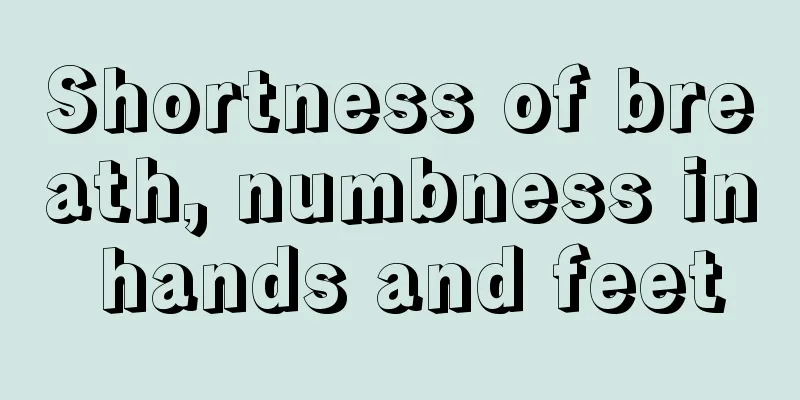Shortness of breath, numbness in hands and feet

|
When our emotions fluctuate greatly, we may experience shortness of breath and numbness in our hands and feet. But everyone should also note that in addition to mood swings, some diseases can also cause these symptoms. Especially respiratory diseases, such as asthma, respiratory allergies, etc. It is recommended that you go to the hospital for examination in time when you experience shortness of breath or numbness in your hands and feet to avoid delaying treatment. Tachypnea is rapid, shallow breathing, with a respiratory rate of more than 24 breaths per minute. It is a common respiratory symptom in clinical practice. It is often an early symptom of respiratory diseases or respiratory insufficiency caused by lesions of organs or tissues that control and affect breathing. Further worsening of the disease may lead to respiratory distress or difficulty breathing, or even respiratory failure, which is life-threatening. Due to the anatomical and physiological characteristics of the respiratory system, infants are more likely to experience shortness of breath and respiratory distress once illness affects their breathing. Treatment should focus on finding the primary disease causing shortness of breath and treating the cause. Provide airway opening, improved ventilation and oxygen supply. There are many reasons for shortness of breath, which may be caused by diseases of the respiratory system itself, or by diseases of the central nervous system, cardiovascular, abdominal, gastrointestinal, metabolic, endocrine and blood systems. Rapid and shallow breathing is seen in respiratory muscle paralysis, severe bloating, ascites and obesity, as well as lung diseases such as pneumonia, pleurisy, pleural effusion and pneumothorax. Deep and rapid breathing is seen during strenuous exercise because the body's increased oxygen supply requires increased gas exchange in the lungs. In addition, when one is emotionally excited or overly nervous, one often breathes deeply and rapidly, and hyperventilates. At this time, the partial pressure of carbon dioxide in the arterial blood decreases, causing respiratory alkali poisoning. Patients often feel numbness around the mouth and extremities. In severe cases, tetany and respiratory arrest may occur. In severe metabolic acidosis, deep and slow breathing also occurs. This is because the extracellular fluid bicarbonate is insufficient and the pH is lowered, so the lungs expel CO2 to compensate and regulate the extracellular acid-base balance. This is seen in diabetic ketoacidosis and uremic acidosis. This deep breathing is also called Kussmaul breathing. A careful history and physical examination can usually provide the likely site and cause of the lesion. In addition to respiratory rate, depth, rhythm, symmetry, respiratory effort (respiratory muscle work) and lung auscultation, the physical examination assessment also includes general reactions, state of consciousness, vital signs (heart rate, pulse, blood pressure, body temperature, etc.) and systemic circulation perfusion, so as to understand the severity of the disease. If necessary, perform tests such as peak expiratory flow rate (PEFR), breath-hold test, and respiratory muscle function measurement. |
<<: How to recover from kidney damage caused by drinking
>>: Soaking your feet in peppercorns can hurt your kidneys
Recommend
It is very important for women to prevent lung cancer by doing these
For women, how to prevent lung cancer is an urgen...
Drinking liquor for oral ulcers
If a person often eats irritating food, the irrit...
What are the causes and symptoms of the straightening of the physiological curvature of the cervical spine
The cause of straightening of the physiological c...
What is calcification?
Calcification is a disease caused by inflammation...
Can normal people take aphrodisiacs?
For male friends, as they get older, physical pro...
Which is the best hospital for treating nasopharyngeal carcinoma?
After nasopharyngeal cancer is diagnosed, the pat...
What are the symptoms of early esophageal cancer?
Esophageal cancer is a common malignant tumor of ...
Bamboo fiber underwear
Underwear is something we wear often. There are m...
What is the reason for the numbness of the lower teeth
Teeth are very important to us. In addition to th...
What are the symptoms of Sjögren's syndrome
In spring and autumn, the weather is relatively d...
Are nematodes harmful to humans?
There are many tiny worms in our daily life that ...
Can patients with hepatitis B virus (HBV) drink alcohol?
Patients with small triple positive should pay at...
The harm of sleeping with wet hair
After washing your hair at night, you must wait f...
How to distinguish between prostate cancer and prostate hyperplasia
Xiao Wang has been frowning recently. He is too e...
Analysis of the causes of shrimp arsenic poisoning
Shrimp poisoning is easy to occur in life because...









